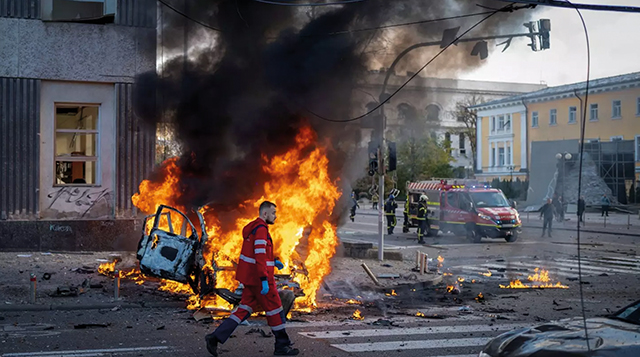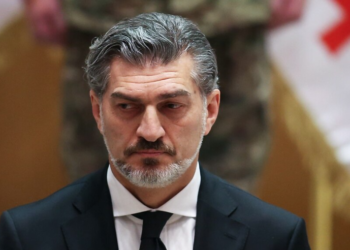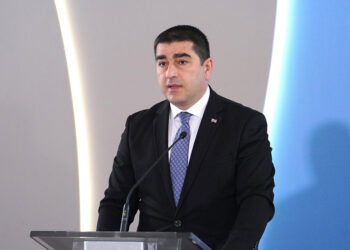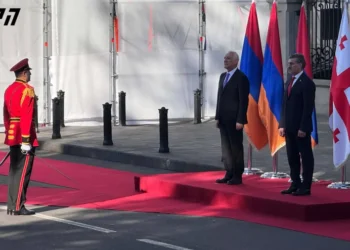Following the promotion of General Sergey Surovikin to the post of Commander of All Russian Forces in Ukraine, Kyiv witnessed a change in tactics. On October 10, waves of cruise missiles and “kamikaze” attack drones filled the skies over Ukraine’s cities as the so-called “General Armageddon” ordered one of the largest missile strikes in the war. However, these munitions were not hurtling towards military bases, forward fighting positions, or even supply depots: They were headed for the civilian city centers.
In the weeks that followed, more waves of missiles struck civilian infrastructure hubs across the country. According to Ukrainian President Volodymyr Zelensky, around six million people are suffering with outages of electricity, heating, and water. Despite massive efforts by Kyiv, as well as NATO and EU allies, to curb the effect of these strikes, the looming winter stands to take an immense toll on the already shaken Ukrainian people.
While the effect of these missiles against military targets may halt or slow any Ukrainian advances on the battlefield, their application against civilians will not. In fact, there has been little to no observable effect on Kyiv’s military ambitions. So the question is: Why does Russia openly fire on civilians, and can it force the country to capitulate using this tactic?
The concept of targeting the civil foundation that supports the military apparatus is something that became a formal component with the advent of aircraft and strategic munitions. While some examples exist in the First World War, it was WWII that saw this become doctrine for both sides. The concept of “strategic bombing” was modernized, using aircraft and missile assets to destroy the enemy’s ability to produce, sustain, and train military forces. However, the dark cousin to this tactic is terror bombing – the targeting of civilian centers to reduce and destroy the morale of one’s foe.
This twisted approach to strategic bombing targets not only production facilities and economic hubs, but also puts shopping malls, markets, and housing blocks in the crosshairs in an attempt to push the population to an anti-war sentiment. This sentiment is supposed to convince national leadership to sue for peace, or at least come to the negotiations table with a disadvantage. Thus, Russia is directly and indirectly attempting to bomb, restrict, and ultimately freeze the Ukrainian people into submission.
In Russia’s ideal, the Ukrainian people, tired of their relatives dying on the front line as well as their own lives being in danger, would act out, and, whether through popular uprising or forced snap elections, the Zelensky administration would be ousted, a new leader would emerge that would seek a peace deal, and the Kremlin could claim victory. Additionally, the new leadership could be molded into something Moscow could control.
This may answer why Russia is targeting the Ukrainian civilian population. However, this only leads to the second question: Can this technique actually work? Will Kyiv bend to Moscow’s will and separate from the West and NATO? A look at history may shed light on this.
Often referenced by pro-Kremlin social media accounts, the actions of the Allies in WWII against Germany and Japan were the most notable strategic bombing campaign. The firebombing of Tokyo, Dresden, Hamburg, and many other raids leveled cities and resulted in hundreds of thousands of civilian deaths. Hiroshima and Nagasaki, the two sites of America’s first nuclear weapons detonations, laid a precedent that still rings across the pro-Russian military analysis community today.

Conversely, the air mission into Great Britain by the German air force, the Luftwaffe, was targeted at bringing the island nation to its knees and halting any support for its campaigns in Europe. Even with the devastation in London and other cities, the people felt a sense of solidarity with their countrymen fighting across the Channel. When Germany introduced its new cruise missiles, the V2 rocket program, this did little to chip away the Brits’ passion for victory.
The actions of the United States Air Force in Vietnam continued this tactic of attempting to bomb the citizenry into submission. To the contrary, popular support for the North Vietnamese forces soared during the mass bombing operations in the country. Recruitment for the armed forces and guerilla groups increased as more attacks ravaged the countryside, causing the US and allied forces to face increasingly more dedicated resistance on the ground.
In all these examples, the attempts at a munitions-based approach of forcing the people into capitulation became a hopeless dream. Russia has used hundreds of its valuable and expensive precision missile technologies, millions of dollars trying to replace them, and even more trying to imitate them with cheap Iranian ersatz versions. With so much of history indicating that this tactic is a lost cause, Russia’s more recent history in Syria shows why they still believe in this methodology.
General Surovikin, as well as much of the Russian military’s officer corps, gained their combat experience from being deployed in Syria. A part of the deployment against the Islamic State as well as the enemies of Syrian President Bashar al-Assad, the tactic of bombing cities and settlements came out of necessity. The Russian military, unable to combat an asymmetric force like the Syrian rebels with conventional force, and unwilling to develop a counter insurgency model like the United States and NATO, resorted to blunt force.
Since the rebels were intricately woven into the communities that supported them, there was no distinction between armed insurgents and civilians. Bombing included hospitals to curtail the return of wounded enemy fighters, markets to throttle their supplies, and villages and towns to remove their supporters. Despite the sheer brutality and horror of this campaign, it worked. The overarching objective of keeping al-Assad in power was achieved, something many military analysts agree would not be possible without such foreign intervention.
However, Ukraine is not Syria. The Kremlin, applying a one-bomb-fits-all approach to the problem, failed to recognize the overt differences between the two. In Syria, Russia faced an irregular force, with almost no technological sophistication, no air force, and little in the way of mechanized armor forces.
In addition, the Syrian anti-government and pro-democracy armies received very little from foreign countries, aside from small arms shipments that came few and far between.
Ukraine couldn’t be more of a polar opposite. Kyiv had spent years since the first incursion in 2014 modernizing and retraining its forces. The Ukrainian Armed Forces had virtually reinvented its battlefield management and command model with help from NATO. After the invasion, the Kremlin likely never thought they would have to contend with the armory of Europe, Australia, the United States, and the United Kingdom coming to bear in Ukraine’s defense.
As a result, the Russian military, again incapable of innovation or creativity, resorted to the same clockwork routine of irreverent bombing and crude missile strikes. With the observable inability to defeat the Ukrainian forces on the battlefield, the Kremlin has settled on killing innocent people in their homes and claiming this, in some way, warrants a military success.
Ultimately, the answer to the aforementioned question is a resounding ‘no’. Russian command cannot hope to win this war by attempting to bomb the population into forcing Kyiv to capitulate. Ukraine has already firmly made its position clear that defeat is not an option. With more major defeats than significant victories, the Kremlin is running short on its own options. As the popular online saying goes, “the Russian army was thought to be the second best in the world. It turns out it’s only the second best army in Ukraine.”
By Michael Godwin














